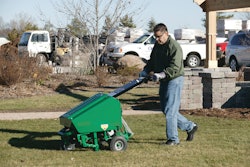
Tine wear rates vary greatly depending on soil conditions, application and size of area impacted. There are some things you can keep in mind to ensure they are performing properly and are replaced when necessary.
Choose wisely
Spike tines, while they may last longer, may not offer the results needed in all soil types. Sandy soils will benefit best from spike aeration as the soil is loose and will compact less as the spike drives into the soil. A core aerator tine works best in thicker or clay-based soils by cutting out and removing a plug.
Keep an eye on the tine
By design, tines sharpen themselves as they wear. There are some things to look for to make sure the tines are performing properly and giving you the best-quality hole. Hollow tines may have the ends roll over or bend. When this occurs, the tine will not pull a good core nor eject the plug properly.
When replacement is necessary
There is no real way to prevent core tines from bending and breaking, and they cannot be easily repaired. The size of the tine opening and the area where the tine is ejected is very critical to the design of the tine and the quality of the core that you pull. When you bend a tine, you ruin the correlation of the opening to the ejection port and it must be replaced.
As spike tines wear, they will get shorter and affect aeration depth. Longer tines are more beneficial for aeration. Tines should be replaced when they have worn down at least one inch.



















